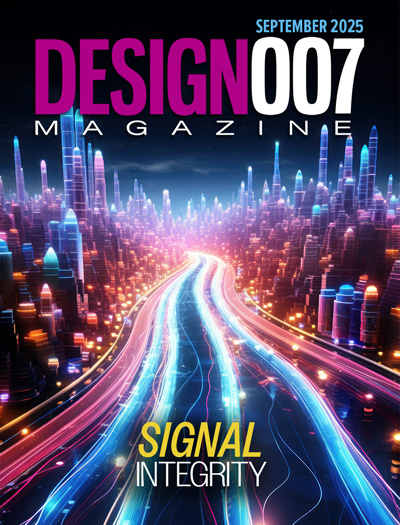-

- News
- Books
Featured Books
- design007 Magazine
Latest Issues
Current Issue
Power Integrity
Current power demands are increasing, especially with AI, 5G, and EV chips. This month, our experts share “watt’s up” with power integrity, from planning and layout through measurement and manufacturing.

Signal Integrity
If you don’t have signal integrity problems now, you will eventually. This month, our expert contributors share a variety of SI techniques that can help designers avoid ground bounce, crosstalk, parasitic issues, and much more.

Proper Floor Planning
Floor planning decisions can make or break performance, manufacturability, and timelines. This month’s contributors weigh in with their best practices for proper floor planning and specific strategies to get it right.
- Articles
- Columns
- Links
- Media kit
||| MENU - design007 Magazine
Electronic Design Automation Market Valuation is Poised to Reach $35.3 Billion By 2032
August 8, 2024 | Globe NewswireEstimated reading time: 9 minutes
The global electronic design automation market is projected to hit the market valuation of US$35.3 billion by 2032 from $15.8 billion in 2023 and at a CAGR of 9.75% during the forecast period 2024–2032.
The EDA market is experiencing significant growth, driven by increasing complexity of semiconductor designs, the proliferation of IoT devices, and the implementation of 5G technology. The market's expansion is further fueled by the rising demand for advanced electronic components in various sectors, including automotive, aerospace, and consumer electronics. One of the most prominent factors contributing to the rise of the electronic design automation market is the increasing complexity of integrated circuits (ICs) and printed circuit boards (PCBs). The advent of very large-scale integration (VLSI) systems has necessitated the development of sophisticated electronic design automation tools to manage the intricate design processes. For instance, Siemens' launch of the Questa verification IQ software in January 2023 addresses the challenges posed by complex IC designs.
Additionally, the automotive industry's shift towards advanced driver-assistance systems (ADAS), infotainment systems, and electric vehicle components has significantly boosted the demand for electronic design automation tools. The Asia Pacific region, in particular, is witnessing rapid growth in this sector, driven by the development of autonomous driving and connectivity features in vehicles. North America remains a key player. Europe is also witnessing a surge in demand due to the expansion of the electronics sector, with a notable increase in electronic design automation tool adoption.
Technological Advancements and Market Dynamics
Technological advancements and strategic collaborations among key industry players are pivotal in driving the electronic design automation market's growth. Companies like Ansys and Microsoft have expanded their partnerships to enhance the accessibility of simulation solutions, while Synopsys continues to innovate with new product launches. The integration of cloud-based deployment models is another trend gaining traction, offering scalable and efficient solutions for electronic design automation tool deployment. Cloud-based electronic design automation tools have seen an adoption rate increase by 40% over the past year. Furthermore, the rising adoption of connected devices, including smart home appliances and industrial sensors, underscores the growing need for sophisticated electronic design automation tools to design and validate these complex systems. As the market evolves, stakeholders are increasingly focusing on optimizing performance, power, and area of electronic components, ensuring the electronic design automation market remains a critical enabler of technological progress. Artificial intelligence (AI) and machine learning (ML) are increasingly being integrated into electronic design automation tools, with 25% of new tools incorporating these technologies.
Electronic design automation tool usage for IoT devices has grown by 30%. Automotive electronic design automation tools have seen a 20% increase in demand due to the rise of electric and autonomous vehicles. Electronic design automation software for 5G infrastructure has experienced a growth rate of 45%. The global semiconductor industry is heavily reliant on electronic design automation tools, with 90% of companies utilizing them in their design processes. Electronic design automation tools for consumer electronics have shown a 15% increase in adoption. The medical electronics sector has seen a 10% rise in electronic design automation tool usage. Smart manufacturing initiatives are driving the demand for electronic design automation tools, with a 35% increase observed. The defense and aerospace sectors are also significant contributors, with a 50% increase in electronic design automation tool adoption for advanced electronic systems.
On-Premise ED Solutions Driving Efficiency, Security, and Collaboration: Contribute Over % Revenue
End users of electronic design automation market are increasingly opting for on-premise deployment as it offers setups offer unparalleled control over data security and intellectual property. In EDA, where proprietary designs and sensitive data are paramount, the ability to manage security protocols internally is a significant advantage. Additionally, on-premise systems provide lower latency, crucial for the high-performance computing needs of EDA tasks. The direct access to hardware resources without the intermediary of a cloud service results in faster processing times and reduced downtime, ensuring uninterrupted design workflows.
The cost-effectiveness of on-premise deployment is another factor driving its popularity. Although the initial investment in infrastructure may be higher, the long-term operational costs tend to be lower. Companies can avoid recurring subscription fees associated with cloud services, leading to substantial savings over time. Moreover, on-premise solutions offer greater customization capabilities. Firms can tailor their EDA tools and workflows to their specific needs, enhancing efficiency and productivity. This flexibility is particularly beneficial for companies with unique design requirements that off-the-shelf cloud solutions may not adequately address.
Recent examples underscore the benefits of on-premise deployment in the electronic design automation market. In 2023, a leading semiconductor company reported a 20% reduction in design cycle times after shifting to an on-premise EDA setup. Another firm in the automotive sector highlighted the enhanced data sovereignty and compliance with industry regulations achieved through on-premise deployment. A third example comes from an aerospace company that significantly improved its design accuracy by leveraging custom-configured on-premise tools. Additionally, a consumer electronics manufacturer noted the improved collaboration among its geographically dispersed teams, thanks to the seamless integration of on-premise EDA solutions. Lastly, a telecommunications company emphasized the enhanced scalability and performance optimization achieved by maintaining control over its infrastructure. These examples illustrate the tangible benefits that make on-premise deployment a preferred choice for many EDA end users.
Simulation Tools Propel Electronic Design Automation to New Heights: Capture Over 36.8% Market Share
The rapid growth and widescale adoption of simulation tools in the Electronic Design Automation market can be attributed to several key factors. Wherein, the increasing complexity of integrated circuits and electronic systems necessitates more sophisticated and accurate simulation tools. For instance, with the advent of 5G technology, AI, and IoT devices, the demand for high-performance, reliable, and energy-efficient designs has surged. This has driven the need for advanced simulation tools that can predict the behavior of electronic circuits with high precision, thereby reducing the risk of costly design errors. Furthermore, the trend towards miniaturization in electronics, as exemplified by the development of 7nm and 5nm technology nodes, requires precise simulations to ensure that designs meet stringent performance and power requirements. Tools such as Cadence Virtuoso, Synopsys HSPICE, and ANSYS HFSS have become indispensable in this context, enabling designers to simulate and verify their designs under various conditions before physical prototypes are created.
In terms of revenue generation, simulation tools surpass verification, design, and Design for Manufacturability (DFM) tools due to their critical role in the design workflow in the electronic design automation market. Simulation tools are used extensively throughout the design cycle, from initial concept and feasibility studies to final validation and optimization. This continuous usage translates into higher demand and, consequently, higher revenue. For example, the development of electric vehicles (EVs) relies heavily on simulation tools to ensure battery efficiency and thermal management, driving significant investment in these tools. According to recent industry data, the average annual spend on simulation tools by leading semiconductor companies is around $150 million, compared to $100 million on verification tools, $90 million on design tools, and $70 million on DFM tools.
Additionally, the number of simulation tool licenses issued annually has exceeded 10,000, reflecting their widespread adoption. Companies like TSMC and Intel utilize simulation tools extensively, with TSMC reporting a reduction in time-to-market by six months due to improved simulation capabilities. Similarly, Intel has integrated simulation tools into their design pipeline, leading to a 30% reduction in design iterations. This significant reliance on simulation tools underscores their pivotal role in driving the EDA industry's growth and revenue.
Unstoppable Rise of Electronic Design Automation Market is Transforming Consumer Electronics, Set to Capture Over 22% Market Share at CAGR of 10.22
The consumer electronics industry is uniquely positioned to benefit significantly from the EDA market. The rapid pace of technological advancements and the increasing complexity of electronic devices necessitate sophisticated design tools that EDA provides. Companies like Synopsys, Cadence, and Siemens EDA are leading the charge by offering comprehensive solutions tailored to the needs of the consumer electronics sector. These tools enable the efficient design and verification of integrated circuits (ICs), printed circuit boards (PCBs), and other critical components, which are essential for the development of modern consumer electronics.
One of the primary drivers of growth in the electronic design automation market for consumer electronics is the increasing demand for smart devices such as smartphones, laptops, and tablets. The proliferation of these devices is fueled by rising disposable incomes in developing economies and the growing adoption of connected devices. Additionally, the shift towards cloud computing and the use of Hyper-Converged Infrastructure (HCI) platforms have significantly reduced the costs associated with hardware purchasing, software licensing, and support, making EDA tools more accessible to a broader range of companies. Government initiatives in countries like India and China, which include substantial funding and supportive policies for semiconductor design startups, further bolster the EDA market.
The consumer electronics segment accounted for around 30% of the EDA market share in 2022, highlighting its significant role in driving market growth. The United States, a major hub for semiconductor R&D and design, is projected to see a market value of $3.28 billion in 2024, driven by the extensive use of EDA tools in consumer electronics and automotive industries. Furthermore, the European Union's Chips Act, with an investment of $43 billion, aims to double the semiconductor market share by 2030, indicating a robust future for EDA in consumer electronics. These factors collectively underscore the pivotal role of EDA in the ongoing evolution and expansion of the consumer electronics industry.
Top 6 Electronic Design Automation Market Giants are Commanding Over 63% of Global Revenue
The electronic design automation market is highly consolidated, with the top six players—Synopsys, Inc., Cadence Design Systems, Inc., Siemens AG, Keysight Technologies, Inc., ANSYS, Inc., and Zuken Inc.—collectively capturing over 63% of the market revenue. Synopsys, Inc. leads the market with a significant share of 21.4%, leveraging its extensive portfolio and strategic acquisitions to maintain its dominance. The company's focus on inorganic growth strategies, such as partnerships and acquisitions, has enabled it to expand its technological capabilities and market reach. For instance, Synopsys' acquisition of Magma Design Automation and its recent deal to acquire ANSYS for $35 billion highlight its aggressive expansion tactics.
Cadence Design Systems, Inc. follows closely behind Synopsys, with a robust presence across North America, Europe, Asia-Pacific, and the Middle East and Africa. Cadence's strategy revolves around heavy investment in research and development, which strengthens its patent portfolio and drives innovation in its product offerings. The company's collaboration with Samsung Foundry to accelerate 3D-IC design exemplifies its commitment to staying at the forefront of technological advancements. Additionally, Cadence's global footprint and diversified product range, including computer-aided engineering (CAE) and semiconductor IPs, position it as a formidable competitor in the electronic design automation market.
Siemens AG, Keysight Technologies, Inc., ANSYS, Inc., and Zuken Inc. also play crucial roles in the EDA market. Siemens AG, with its strong distribution network and subsidiaries like Mentor Graphics, maintains a significant market share. Keysight Technologies focuses on providing advanced electronic measurement solutions, which complement its EDA tools. ANSYS, known for its simulation and analysis software, recently became a part of Synopsys, further consolidating the market. Zuken Inc., although smaller in comparison, continues to innovate in PCB and MCM design, contributing to the overall competitiveness of the market. Collectively, these companies drive the electronic design automation market growth through continuous innovation, strategic partnerships, and a focus on expanding their global presence.
Testimonial
"In a year when every marketing dollar mattered, I chose to keep I-Connect007 in our 2025 plan. Their commitment to high-quality, insightful content aligns with Koh Young’s values and helps readers navigate a changing industry. "
Brent Fischthal - Koh YoungSuggested Items
NEDME 2025 Draws Strong Northwest Crowd, Builds on Tradition of Regional Collaboration
10/31/2025 | NEDMEThe NW Electronics Design & Manufacturing Expo (NEDME) 2025 once again brought together the Pacific Northwest community for a full day of learning, networking, and industry connections.
Keysight Advances Quantum Engineering with New System-Level Simulation Solution
10/30/2025 | BUSINESS WIREKeysight Technologies, Inc. announced the release of Quantum System Analysis, a breakthrough Electronic Design Automation (EDA) solution that enables quantum engineers to simulate and optimize quantum systems at the system level.
WestDev Announces Advanced Thermal Analysis Integration for Pulsonix PCB Design Suite
10/29/2025 | WestDev Ltd.Pulsonix, the industry-leading PCB design software from WestDev Ltd., announced a major enhancement to its design ecosystem: a direct interface between Pulsonix and ADAM Research's TRM (Thermal Risk Management) analysis software.
Industry Veteran Dr. Helen Song Joins Celera Semiconductor to Lead Product Design
10/28/2025 | PRNewswireCelera Semiconductor, the analog industry leader using AI to automate the entire product development flow, today announced that Dr. Helen Song has joined the company as vice president of Product Design.
Mapping the EV Landscape: Markets, Platforms, and Powertrains
10/28/2025 | Stanton Rak, SF Rak Companye-Mobility is the defining transformation of 21st-century transportation. As legacy OEMs, startups, and governments race to electrify vehicle fleets, the landscape of e-Mobility is expanding into previously unimaginable territory. But with innovation comes complexity, and with complexity, a need for systems that are not only high-performing but also reliably engineered for the long haul. Understanding the diversity and scale of the EV marketplace is essential to grasping the reliability challenges ahead.


